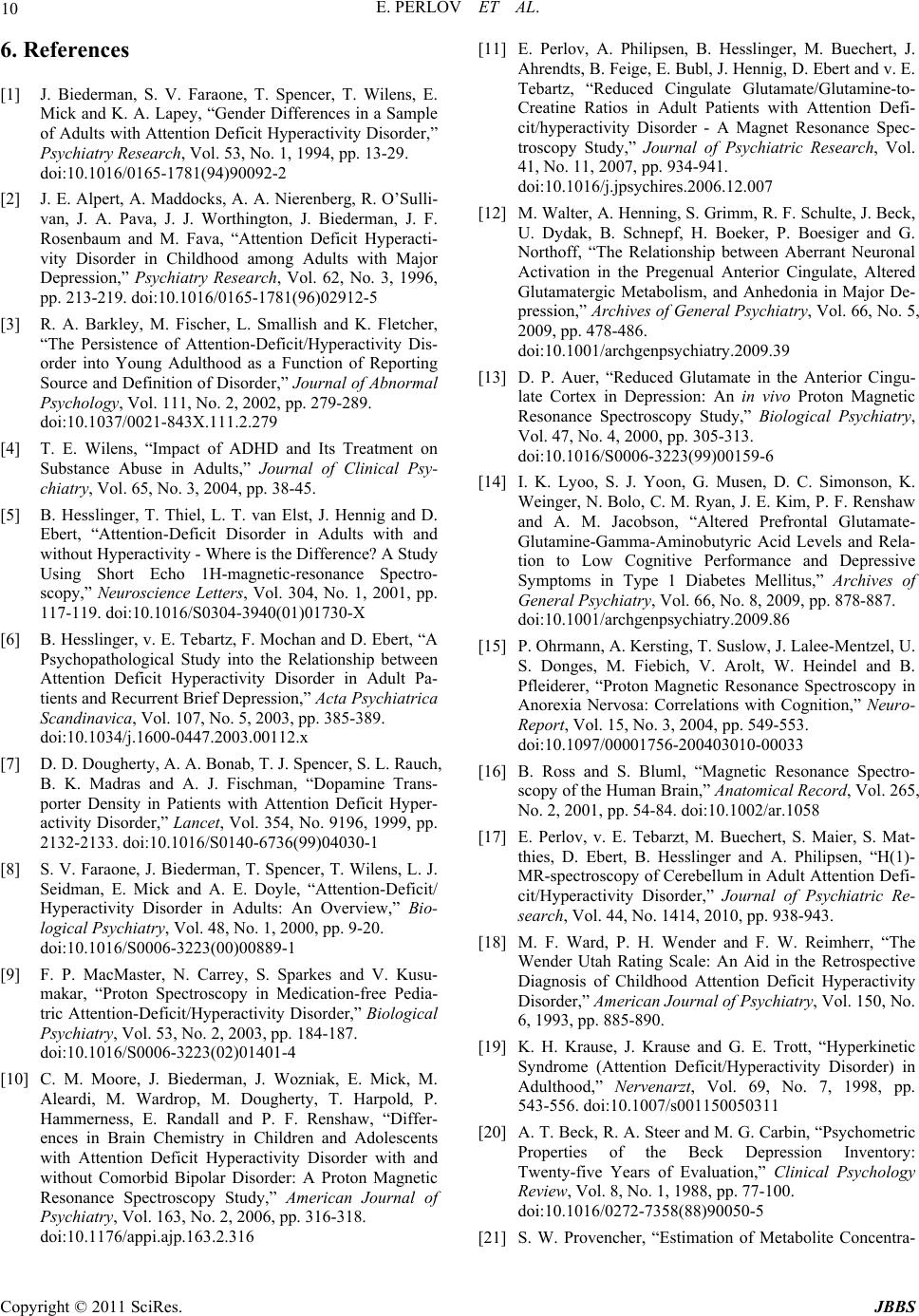
10 E. PERLOV ET AL.
6. References
[1] J. Biederman, S. V. Faraone, T. Spencer, T. Wilens, E.
Mick and K. A. Lapey, “Gender Differences in a Sample
of Adults with Attention Deficit Hyperactivity Disorder,”
Psychiatry Research, Vol. 53, No. 1, 1994, pp. 13-29.
doi:10.1016/0165-1781(94)90092-2
[2] J. E. Alpert, A. Maddocks, A. A. Nierenberg, R. O’Sulli-
van, J. A. Pava, J. J. Worthington, J. Biederman, J. F.
Rosenbaum and M. Fava, “Attention Deficit Hyperacti-
vity Disorder in Childhood among Adults with Major
Depression,” Psychiatry Research, Vol. 62, No. 3, 1996,
pp. 213-219. doi:10.1016/0165-1781(96)02912-5
[3] R. A. Barkley, M. Fischer, L. Smallish and K. Fletcher,
“The Persistence of Attention-Deficit/Hyperactivity Dis-
order into Young Adulthood as a Function of Reporting
Source and Definition of Disorder,” Journal of Abnormal
Psychology, Vol. 111, No. 2, 2002, pp. 279-289.
doi:10.1037/0021-843X.111.2.279
[4] T. E. Wilens, “Impact of ADHD and Its Treatment on
Substance Abuse in Adults,” Journal of Clinical Psy-
chiatry, Vol. 65, No. 3, 2004, pp. 38-45.
[5] B. Hesslinger, T. Thiel, L. T. van Elst, J. Hennig and D.
Ebert, “Attention-Deficit Disorder in Adults with and
without Hyperactivity - Where is the Difference? A Study
Using Short Echo 1H-magnetic-resonance Spectro-
scopy,” Neuroscience Letters, Vol. 304, No. 1, 2001, pp.
117-119. doi:10.1016/S0304-3940(01)01730-X
[6] B. Hesslinger, v. E. Tebartz, F. Mochan and D. Ebert, “A
Psychopathological Study into the Relationship between
Attention Deficit Hyperactivity Disorder in Adult Pa-
tients and Recurrent Brief Depression,” Acta Psychiatrica
Scandinavica, Vol. 107, No. 5, 2003, pp. 385-389.
doi:10.1034/j.1600-0447.2003.00112.x
[7] D. D. Dougherty, A. A. Bonab, T. J. Spencer, S. L. Rauch,
B. K. Madras and A. J. Fischman, “Dopamine Trans-
porter Density in Patients with Attention Deficit Hyper-
activity Disorder,” Lancet, Vol. 354, No. 9196, 1999, pp.
2132-2133. doi:10.1016/S0140-6736(99)04030-1
[8] S. V. Faraone, J. Biederman, T. Spencer, T. Wilens, L. J.
Seidman, E. Mick and A. E. Doyle, “Attention-Deficit/
Hyperactivity Disorder in Adults: An Overview,” Bio-
logical Psychiatry, Vol. 48, No. 1, 2000, pp. 9-20.
doi:10.1016/S0006-3223(00)00889-1
[9] F. P. MacMaster, N. Carrey, S. Sparkes and V. Kusu-
makar, “Proton Spectroscopy in Medication-free Pedia-
tric Attention-Deficit/Hyperactivity Disorder,” Biological
Psychiatry, Vol. 53, No. 2, 2003, pp. 184-187.
doi:10.1016/S0006-3223(02)01401-4
[10] C. M. Moore, J. Biederman, J. Wozniak, E. Mick, M.
Aleardi, M. Wardrop, M. Dougherty, T. Harpold, P.
Hammerness, E. Randall and P. F. Renshaw, “Differ-
ences in Brain Chemistry in Children and Adolescents
with Attention Deficit Hyperactivity Disorder with and
without Comorbid Bipolar Disorder: A Proton Magnetic
Resonance Spectroscopy Study,” American Journal of
Psychiatry, Vol. 163, No. 2, 2006, pp. 316-318.
doi:10.1176/appi.ajp.163.2.316
[11] E. Perlov, A. Philipsen, B. Hesslinger, M. Buechert, J.
Ahrendts, B. Feige, E. Bubl, J. Hennig, D. Ebert and v. E.
Tebartz, “Reduced Cingulate Glutamate/Glutamine-to-
Creatine Ratios in Adult Patients with Attention Defi-
cit/hyperactivity Disorder - A Magnet Resonance Spec-
troscopy Study,” Journal of Psychiatric Research, Vol.
41, No. 11, 2007, pp. 934-941.
doi:10.1016/j.jpsychires.2006.12.007
[12] M. Walter, A. Henning, S. Grimm, R. F. Schulte, J. Be ck,
U. Dydak, B. Schnepf, H. Boeker, P. Boesiger and G.
Northoff, “The Relationship between Aberrant Neuronal
Activation in the Pregenual Anterior Cingulate, Altered
Glutamatergic Metabolism, and Anhedonia in Major De-
pression,” Archives of General Psychiatry, Vol. 66, No. 5,
2009, pp. 478-486.
doi:10.1001/archgenpsychiatry.2009.39
[13] D. P. Auer, “Reduced Glutamate in the Anterior Cingu-
late Cortex in Depression: An in vivo Proton Magnetic
Resonance Spectroscopy Study,” Biological Psychiatry,
Vol. 47, No. 4, 2000, pp. 305-313.
doi:10.1016/S0006-3223(99)00159-6
[14] I. K. Lyoo, S. J. Yoon, G. Musen, D. C. Simonson, K.
Weinger, N. Bolo, C. M. Ryan, J. E. Kim, P. F. Renshaw
and A. M. Jacobson, “Altered Prefrontal Glutamate-
Glutamine-Gamma-Aminobutyric Acid Levels and Rela-
tion to Low Cognitive Performance and Depressive
Symptoms in Type 1 Diabetes Mellitus,” Archives of
General Psychiatry, Vol. 66, No. 8, 2009, pp. 878-887.
doi:10.1001/archgenpsychiatry.2009.86
[15] P. Ohrmann, A. Kersting, T. Suslow, J. Lalee -Mentzel, U.
S. Donges, M. Fiebich, V. Arolt, W. Heindel and B.
Pfleiderer, “Proton Magnetic Resonance Spectroscopy in
Anorexia Nervosa: Correlations with Cognition,” Neuro-
Report, Vol. 15, No. 3, 2004, pp. 549-553.
doi:10.1097/00001756-200403010-00033
[16] B. Ross and S. Bluml, “Magnetic Resonance Spectro-
scopy of the Human Brain,” Anatomical Record, Vol. 265,
No. 2, 2001, pp. 54-84. doi:10.1002/ar.1058
[17] E. Perlov, v. E. Tebarzt, M. Buechert, S. Maier, S. Mat-
thies, D. Ebert, B. Hesslinger and A. Philipsen, “H(1)-
MR-spectroscopy of Cerebellum in Adult Attention Defi-
cit/Hyperactivity Disorder,” Journal of Psychiatric Re-
search, Vol. 44, No. 1414, 2010, pp. 938-943.
[18] M. F. Ward, P. H. Wender and F. W. Reimherr, “The
Wender Utah Rating Scale: An Aid in the Retrospective
Diagnosis of Childhood Attention Deficit Hyperactivity
Disorder,” American Journal of Psychiatry, Vol. 150, No.
6, 1993, pp. 885-890.
[19] K. H. Krause, J. Krause and G. E. Trott, “Hyperkinetic
Syndrome (Attention Deficit/Hyperactivity Disorder) in
Adulthood,” Nervenarzt, Vol. 69, No. 7, 1998, pp.
543-556. doi:10.1007/s001150050311
[20] A. T. Beck, R. A. Steer and M. G. Carbin, “Psychometric
Properties of the Beck Depression Inventory:
Twenty-five Years of Evaluation,” Clinical Psychology
Review, Vol. 8, No. 1, 1988, pp. 77-100.
doi:10.1016/0272-7358(88)90050-5
[21] S. W. Provencher, “Estimation of Metabolite Concentra-
Copyright © 2011 SciRes. JBBS